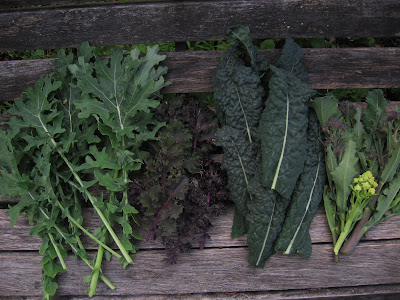
There are striking similarities among the broccoli, kale, and arugula plants, all flourishing right now in our backyard. The sibling resemblances should not come as any surprise since they are in the same family, the Cruciferae, also known as Brassicaceae (that is how it's spelled -- I checked). Personally, I think of them as Cruciferae. For one thing, it's easier to pronouce.
They are also in the same sub-group or genus within this huge family. The genus is known as
the brassicas. It contains more important agricultural and horticultural plants than any other genus. (Isn't Wikipedia wonderful?) There are your cabbages, your turnips, your brussels sprouts, your kohlrabi, cauliflower, broccoli, mustards, on and on, and that's just the vegetables. A farmer's market of cousins.
Above is Purple Sprouting Broccoli, doing its thing. From this plant we eat the buds.

Here is Dinosaur Kale, also putting out buds and looking a lot like sprouting broccoli. But in this case the appearance of these sprouts means the plant is past its prime (from our perspective) and going to seed. The prized leaves will lose flavor as the plant puts its energy into budding, flowering and seeding.

Here is the lovely blossom of the Dinosaur Kale. The name Cruciferae comes from the four-petaled flowers in the shape of a cross that are a stable characteristic across the entire family of hundreds of sub-groups.

And here are arugula blossoms, also cruciferous. This plant has a nice bud stalk. Would it be good to eat, like broccoli? And what about the Dinosaur Kale buds?
We are very conventional and eat only the customary parts of each of these plants. There is more than enough as it is. But it's nice to know the family tree all the same.























